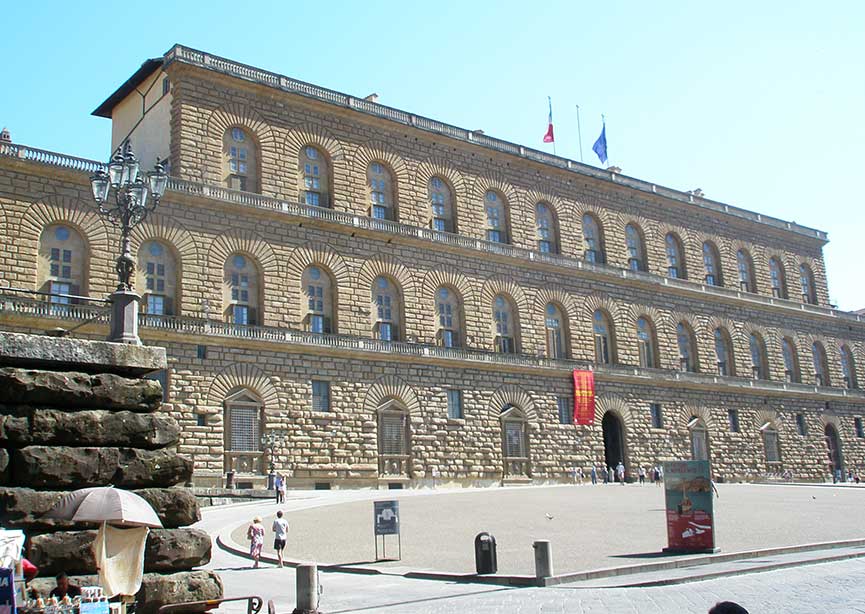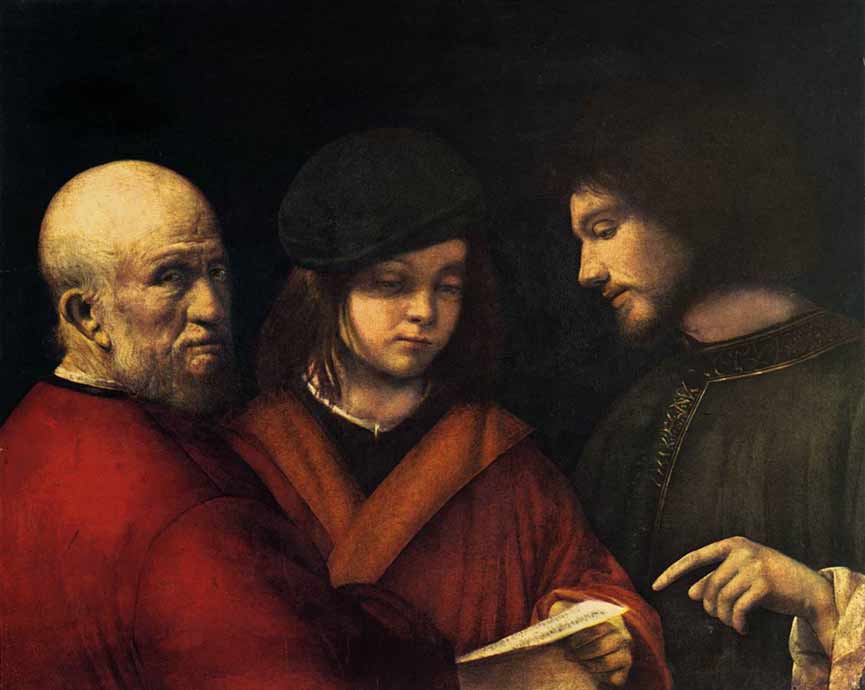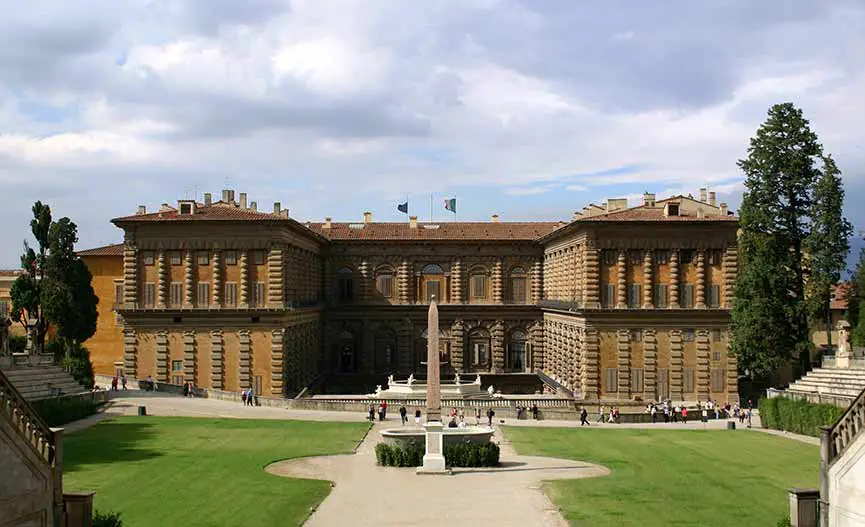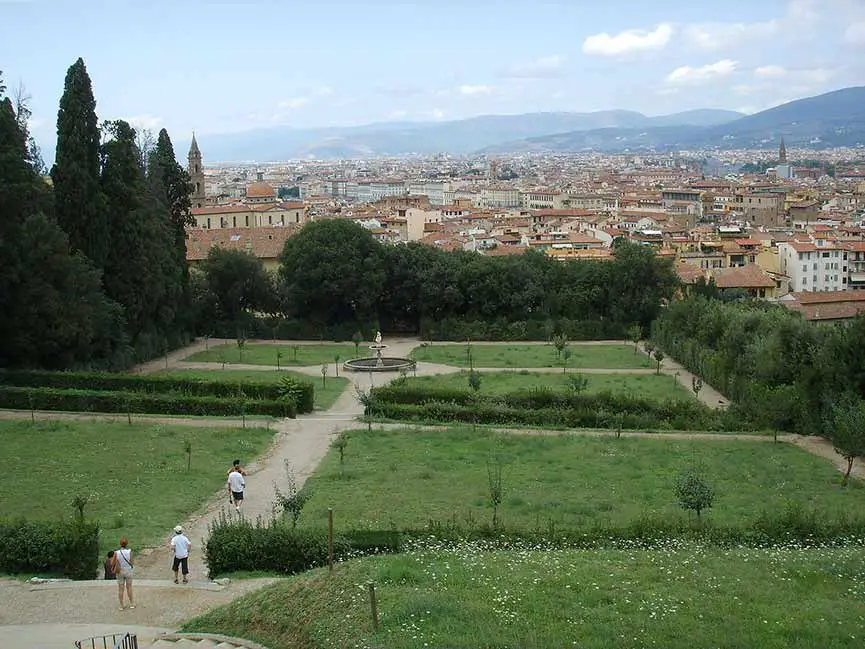|
|
|
 Are you coming to Florence? Book your tour in advance and skip the line! Are you coming to Florence? Book your tour in advance and skip the line!

Choose from more than 50 experiences in Florence : museums, private tours and food tours. |
|
Palazzo Pitti Museum in Florence: buy skip-the-line tickets online
The Palazzo Pitti Museum in Florence: how to get there, the collection on display, history, opening hours, cost nd prices for purchasing tickets and useful information for the visit.
 |
 Palazzo Pitti Museum - Palazzo Pitti, Piazza de' Pitti, 1 - Florence Palazzo Pitti Museum - Palazzo Pitti, Piazza de' Pitti, 1 - Florence
The Pitti Palace Museum is a state museum that is part of the museum pole of the Uffizi Galleries which also includes Uffizi Gallery, the Vasari Corridor, the Boboli Gardens.
Palazzo Pitti, historic residence of the Medici from 1550, then of the Habsburg-Lorraine from 1737 and finally of the Savoy until 1919, houses in its halls the Palatine Gallery, the Modern Art Gallery, the Treasury of the Grand Dukes, the Museum of Fashion and Costume, the Imperial and Royal Apartments, the Carriage Museum. The palace also includes the Boboli Gardens Museum.
Tickets and Guided Tours including the Palazzo Pitti Museum of Florence

Tickets available: Skip-the-line Palazzo Pitti Museum ticket, Guided tour of the Royal and Imperial Apartments, Private tour of the Garden + Pitti Palace, Semi-private tour of the Pitti Palace. |
|
Works from the collection of Palazzo Pitti in Florence
The Palazzo Pitti Collection brings together works from Neoclassicism, Romanticism, the School of Macchiaioli, decadentism, symbolism, post-impressionism and divisionism. Among the exhibited artists Fattori, Hayez, Lega, Signorini, Pissarro, Rosso, Boldini, Nomellini among the exhibited artists.
The Pitti Palace Museum in Florence
Opened in 1919 after the legacy of Vittorio Emanuele III, Palazzo Pitti is actually a museum complex as it houses a considerable number of museums and galleries.
Since 2014 Palazzo Pitti has in turn been part of the museum complex of the Uffizi Galleries.
Galleria Palatina
Together with the Royal and Imperial Apartments, the Palatine Gallery occupies the main floor of the building and houses one of the most important art galleries in the world; here is the largest concentration of Raphael's paintings in the world. The Gallery as it stands was born between the end of the eighteenth century and the beginning of the nineteenth century at the behest of the Lorraines who had 500 paintings belonging to the Medici collections placed here.
In the various rooms, frescoed by Pietro da Cortona from 1640 to 1647, there are also works by Titian, Tintoretto, Caravaggio and Rubens which dialogue with the original furnishings of the rooms that the Grand Duke destined for private use and for state hearings. The Quadreria della Palatina still houses the paintings inside precious carved and gilded frames which are in the original position desired by the Grand Duke to fascinate his guests. This is the largest existing picture gallery in Italy.

(Photo: Three ages of man, Giorgione, 1500-1501)
Royal and Imperial Apartments
They are paired with the Palatine Gallery being the opposite wing of the noble palace. There are a total of 14 rooms which at the beginning of the eighteenth century were the private apartments of the Grand Prince Ferdinando de' Medici and then from 1865 of the sovereigns of Italy Savoy from which they finally took their name.
Here there are smaller rooms than in the Palatine and the furnishings are from the Savoy era with furniture and pieces from the Medici, Lorraine and Savoy collections. In this wing it is possible to immerse oneself in the daily life of the dynasties that lived in Pitti and above all of the Savoys who left the building in 1919.
Gallery of Modern Art
Among the museums housed in Pitti there is also a Modern Art Gallery which occupies the entire second floor of the building and all the rooms of the rear northern side wing, offering the visitor panoramic views of Florence in its 30 rooms. These house a collection of painting and sculpture ranging from the eighteenth century to the early twentieth century.
In these rooms lived the exponents of Lorraine and then those of the Savoy who kept this area of Palazzo Pitti at their disposal well beyond the date of 1919, when visitors were already flowing through the main entrance of the newborn museum.
The exhibition is presented in chronological order and touches the main artists of Neoclassicism, Romanticism, the School of Macchiaioli, Decadence, Symbolism, Post-Impressionism and Divisionism: Fattori, Hayez, Lega, Signorini, Pissarro, Rosso, Boldini, Nomellini among the exhibited artists.
Treasury of the Grand Dukes
In the northern side wing of Palazzo Pitti - once the summer apartment of the Medici family - the Treasury of the Grand Dukes is housed on the ground floor and upper mezzanine in 27 rooms, 14 on the ground floor and 13 on the upper floor, displaying a collection of jewellery, silverware, crystals, ivory and semi-precious stones. The rooms were decorated with frescoes for the marriage between Ferdinando II de' Medici and Vittoria della Rovere (1637). Even if the finds are part of the Medici Treasury, there is also a section dedicated to contemporary jewellery.
 |
|
History of the Pitti Palace Museum in Florence
The history of the Pitti Palace Museum is linked to the Medici family, bankers who rose to power in the 13th century and governed Florence for centuries.
(Photo: Internal facade on the Boboli Gardens. Stefan Bauer, http://www.ferras.at, CC BY-SA 2.5, via Wikimedia Commons)
In 1549 Eleonora di Toledo bought Palazzo Pitti, the historic Renaissance residence of the banker Luca Pitti who had it built - to a design by Filippo Brunelleschi - starting in 1458 at the base of the Boboli hill in the Oltrarno. Pitti was the political rival of Cosimo the Elder, patriarch of the Medici family; legend has it that it required its windows to be larger than the entrance door to Cosimo's palace. Once Brunelleschi died, the architect of the first nucleus of Palazzo Pitti was finally his pupil Luca Fancelli.
At the time of Eleonora's purchase, the building had only three doors and a double row of windows; Bartolomeo Ammannati was then called - who was working on the project for the Fountain of Neptune in Piazza della Signoria - to expand it and transform it into one of the most famous noble palace models in Europe. The construction of Palazzo Pitti and the Boboli Gardens were from that moment carried on together. For the Boboli Gardens, Niccolò Pericoli (1500 - 1550), known as Tribolo, was called in and designed the layout, dividing it into sectors where he planted rare trees and wild plants and arranged the hedges. But Tribolo died prematurely and Ammannati himself took charge of the garden, who designed the Grotta di Madama, built from 1553 to 1555, with the aim of recreating naturalistic environments populated by sculptures depicting mysterious beings and animals.
Meanwhile, the construction of Palazzo Pitti continued as normal with the pietraforte that was quarried in the Garden itself, transforming an area behind the central courtyard into an amphitheater, designed by Tribolo who designed it adorned only with vegetation.
The concurrent development of Palace and Garden quickly led to the creation of the largest and most beautiful palace in Europe which ended up being imitated several times.
The Ammannati court, which according to legend was capable of containing Palazzo Strozzi, was the scene of events that attracted crowned heads from all over Europe, such as in 1569 for the marriage between Ferdinando I de' Medici and Christine of Lorraine.
In the seventeenth century, the facade facing the square was enlarged (1618-1631) which in turn became three times longer and, at the end of the century, the Fonte del Leone was also added, with the Medici grand ducal crown, by Cosimo III (1696).
Under the Lorraines the two advancing wings of the Palazzo were built, with porticoes and terraces, called Rondò, the work of Giuseppe Ruggeri.
Napoleon Bonaparte also stayed there in the early years of the 19th century, who also made it the object of plunder by sending to Paris, and losing along the way, various works contained in Palazzo Pitti.
The return of the Lorraines after the Council of Vienna in 1815 determined the start of a more conservative than innovative restoration.
In 1833, under Leopold II, parts of the palace were opened to the public as a museum. But with the annexation of Tuscany to Piedmont, the building passed under the appurtenances of the Savoy who stayed there from 1865 with Florence as the capital of Italy.
From 1871 the Savoys moved towards the Quirinale because the capital had been moved to Rome. They kept Palazzo Pitti in their properties until 1919 when Vittorio Emanuele III donated it to the State which immediately made it one of the most beautiful state museums in Italy.

(Photo: Vista dalla Kaffeehaus. I, Sailko, CC BY-SA 3.0, via Wikimedia Commons)
Information for visiting the Pitti Palace Museum
Hours: Tuesday to Sunday open at 8.15am to 6.30pm. Last entry 5.30pm.
Closed on the first and last Monday of the month, except between June and October; January 1st; 25th December.
Tickets: full price € 16. concessions € 2. Entry reservation € 3. 5-day passepartout: single entry valid for 5 days for the Uffizi, Palazzo Pitti, Palazzo Pitti museum € 38.
|
|
How to reach the Palazzo Pitti Museum in Florence
The entrance to the Pitti Palace Museum is located in Piazza de' Pitti, 1.
Arriving by train
From Santa Maria Novella station you can get there on foot in about 20 minutes (2km).
Arriving by bus
The closest bus stop is the Pitti line C4 (in front of Palazzo Pitti).
Arriving by car
The closest car parks are Garage Palazzo Vecchio, Garage dei Tintori, Garage Lungarno (for a fee). They are located just 300 meters on foot from the Uffizi Gallery. |
|
|